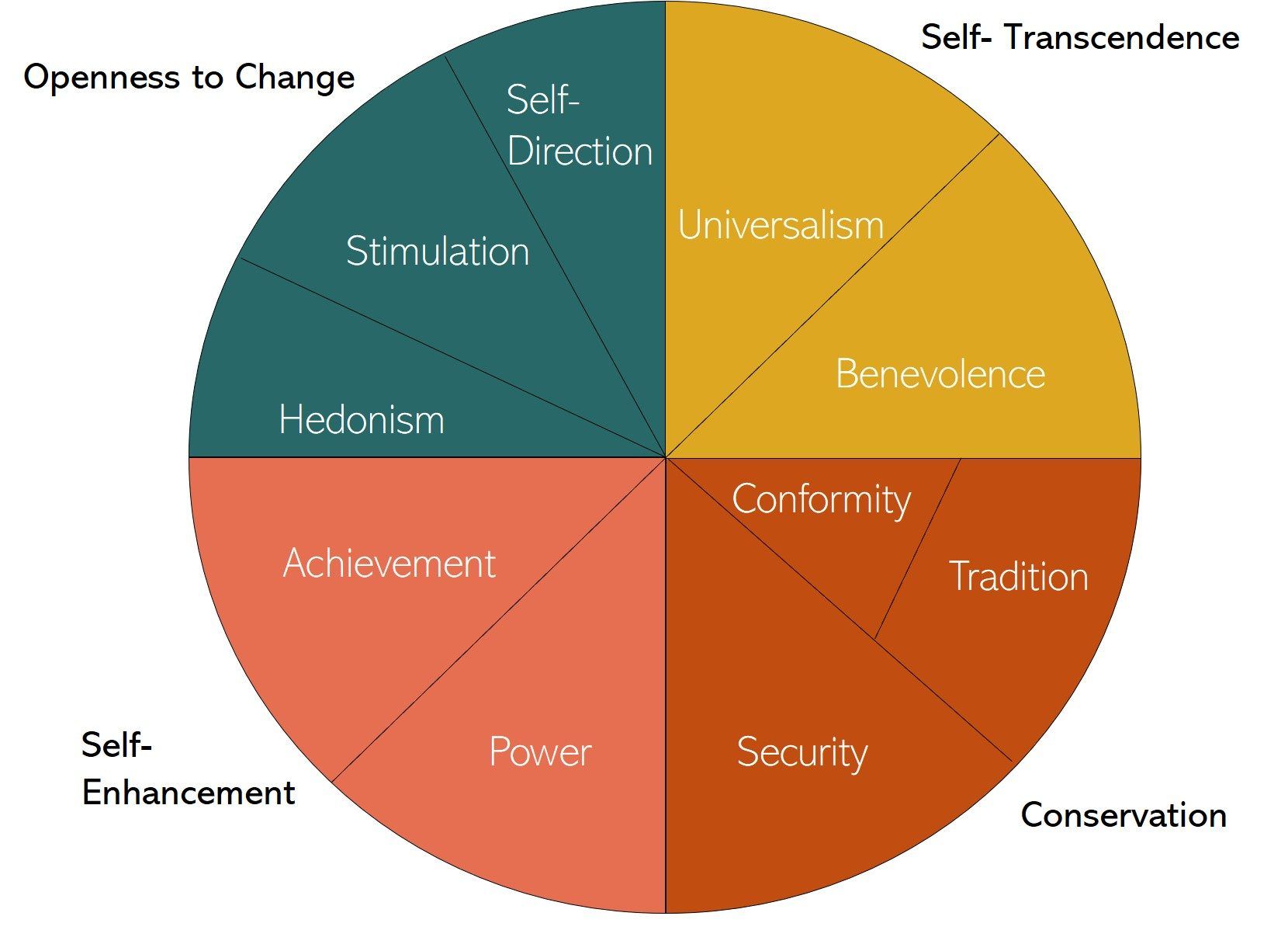Marketing with Meaning:
a practical guide to value-based marketing
Why just talking about sustainability isn’t enough – and what to do instead.

Whether you’re part of a community-supported agriculture scheme, a local food hub, or an organic cooperative, chances are you’re doing something meaningful—but struggling to cut through the noise of conventional food marketing.
The tough truth is: being sustainable usually isn’t enough to win over customers. The majority of people make food choices based on factors like affordability, taste, convenience and health. Sustainability often comes in much later — if at all.
So how do you stand out in a crowded food landscape without watering down your mission? By speaking to what really drives people: their values.
Drawing from social psychology and communications research, we have developed an actionable, concise guidebook to help sustainable food initiatives build powerful Customer Value Propositions (CVPs) that resonate on a deeper level.
Let’s take a deeper look at some of the key ideas and practical steps.
Meet Rutger: a story about more than lettuce
Every Friday after work, Rutger visits a local farm where he pays a small membership fee to harvest his own lettuce. He doesn’t go there for the carbon footprint stats or the organic lettuce. He goes for the joy of slowing down, spending time outdoor, connecting with others, and feeling a sense of achievement.
Your customers, like Rutger, are often looking for products and services that help them live out their values. Your marketing efforts should help them see how your offer fits into that personal story.
Why values matter (and which ones to focus on)
At the heart of the guidebook is the idea that we don’t just buy things to fulfil needs — we buy to express who we are. Our personal values shape what we care about, how we make choices, and how we want to be perceived.
There are 10 universal human values, identified by the social psychologist Schwartz. These values are recognised across cultures and can be grouped into four broader motivational themes:
The 10 Basic Human Values
Self-Enhancement
- Power – Seeking status, prestige, or social recognition.
- Achievement – Pursuing personal success and demonstrating competence.
Openness to Change
- Hedonism – Wanting pleasure, indulgence and sensory enjoyment.
- Stimulation – Craving novelty, excitement and new experiences.
- Self-direction – Valuing independence, freedom and creativity.
Self-Transformation
- Universalism – Caring about the wellbeing of people and nature.
- Benevolence – Looking after loved ones and close communities.
Conservation
- Tradition – Respecting cultural customs and the “old ways”.
- Conformity – Avoiding standing out; valuing social harmony and norms.
- Security – Seeking safety, control and stability.

The trick isn’t to pick the “best” value — it’s to identify which values are important to your target audience , and show how your business supports them in living in alignment with those values.
For instance, someone who values benevolence might love your veg box because it makes it easier to feed their family well. Someone who values stimulation might be drawn to the fact that you introduce new, exciting products each season.
Making your message meaningful
To build a more effective marketing strategy, we recommend using a tool called the Value Proposition Canvas (VPC). It helps you design your products and communication around what really matters to your customers.
At the deepest level, what really matters to your consumers are their values. So, we guide you to apply the VPC through the lens of Schwarz’s basic human values.
First, define these three key aspects of your consumer profile in relation to their values:
- Customer jobs: What is the deeper “job” they want your product to do? In other words, how do your customers want to realise their values.
- Pains: When seeking to realise their values in this way, what do your customers struggle with? What frustrates or prevents them from realising their values?
- Gains: What are your customers hoping to achieve by realising their values through your product? What would give them satisfaction and tell them that using your product is successful for them?
For example, imagine someone is tired of bland supermarket food (pain), wants to reconnect with their cultural roots (gain), and is looking for food that feels authentic (customer job). You can then position your brand as a provider of tradition, quality, and authenticity — speaking directly to those values.
Then, connect your customer’s needs with your offering and identify:
- Products and services: What products or services do you offer which help your customers live better in alignment with their values?
- Pain relievers: What features of your product or service ease frustrations or barriers related to realising values?
- Gain creators: What features of your product benefit your consumers, beyond the functional? How does it help create the output that realises their values?
Our guidebook provides examples of existing products that align with the 10 basic human values. To show you how to apply this model, we break down the VPC associated with each product and their customer’s values.

Make values visible in your messaging
Once you’ve identified the values motivating your target customers, you can adjust your messaging accordingly. Here are a few examples from the guidebook:
- For achievement: Highlight the pride of “doing it yourself” with a mushroom grow kit or hands-on harvest experience.
- For hedonism: Emphasise flavour, pleasure and indulgence — e.g. “fresh, luxurious veg that actually tastes amazing”.
- For security: Offer transparency and reassurance — from certifications to livestreams of your animal welfare practices.
- For universalism: Show how your business supports ethical supply chains, fair wages, or local ecosystems.
Importantly, avoid trying to appeal to opposing values at the same time (e.g. power and universalism), as it can water down your message.
Move away from technical or abstract language (“biodiverse”, “low-impact”, “direct supply chains”) and instead speak in terms of how people feel and what they value.
For example:
- Instead of “Our vegetables are certified organic,” try:
“Food you can feel good about—grown with care for your health and the earth.” - Rather than “Local and seasonal produce,” say:
“Support your local farmers and enjoy food that’s truly in season.”
From ideas to action
The guidebook also includes an ideas evaluation matrix to help you turn value-based ideas into practical next steps. Score each idea based on:
- Feasibility – Can you realistically do this?
- Attractiveness – Will your target audience care?
Ideas that score high on both are where to start. This avoids wasting time on flashy campaigns that don’t align with your values or your audience’s.
Values lead to value
When you communicate with values in mind, you’re not just selling a product. You’re inviting people to live more in line with the kind of life they want — whether that means tradition, taste, trust, or togetherness.
You don’t need to change your mission. You just need to change the way you tell your story.
Want to dive deeper?
Our full guidebook walks you through all of this step-by-step, including practical templates and inspiring case studies.
Interested in getting a copy?
Fill in the form below – we’d be happy to share the full version (at no cost) and help you bring your values to life through your marketing.
We believe that understanding consumers is key to making the food system more sustainable. Successful innovation and impactful communication require a solid foundation of consumer insight.
We are the insights partner of choice for food companies and non-profits that aim to have a positive impact on society and our planet. Together we empower consumers to make food choices that are good for them as well as for the planet.
The Hague Tech - Waldorpstraat 5 - 2521CA - The Hague
(+31) (0)70 2042314 - Info@futureoffood.institute
Contact
Fill in this form and we'll be in touch shortly!
Newsletter
Do you want to receive a monthly dose of insights, opinions and events? Please subscribe to our newsletter.







